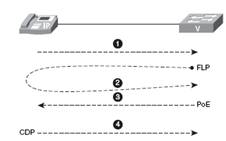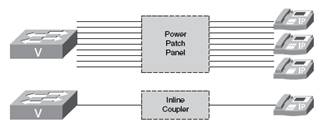- Cisco prestandard (inline power)
- 802.3af standard
Sending electricity over the unused Ethernet wires to power a connected device can be achieved in two ways:
Through inline power or using Power on Ethernet (PoE).
Now days a variety of devices can attach to an Ethernet cable and receive all power required to operate them. Also other than Cisco IP phones, devices such as wireless access points and video surveillance equipment can also use PoE.
Powering on devices using an Ethernet cables has many benefits over conventional ways of powering on equipment as underlined below:
- It is a centralized point of power distribution, as users expect phones to work even if electricity connection is down, in PoE we can connect the switch powering on IP phones to a UPS, which eliminates the need to place UPS at each IP phone.
- PoE enables to power on devices not very convenient located near power outlets.
- PoE eliminates clutter of wires on a user desk
While using PoE we need to ensure the following:
- RJ-45 cabling is tested and certified as per standard
- The IP phone and switch have common PoE delivery method
- The PoE switch has a UPS backup to provide power in the event of power failure
In 2003, PoE become 802.3af standard much later than voice telephony was evolving fast. So some proprietary methods were developed and one such method is inline power. Cisco IP phones support two types of methods.
Cisco inline power is also known as Cisco PoE prestandard. Since Cisco was the earliest VOIP devices vendor many IP phones were procured and deployed much before 802.3af standard came into existence in 2003. Most Cisco IP phones support 802.3af as well as inline mode.
In order to supply an unpowered PoE device, the switch needs to uniquely detect these devices. The main difference between the PoE methods is primarily lies in the way detection happens. Cisco Prestandard PoE uses the following method:
- Cisco prestandard PoE connects to switch physically.
- The switch sends a Fast Link Pulse (FLP) tone signal to unpowered device. Cisco prestandard PoE device loop back the tone.
- When tone is received back by switch, it senses that device is unpowered Cisco prestandard PoE device and applies a minimal amount of power (6.3W) to the line.
- The unpowered device boots and communicates its actual power requirement to the switch using CDP (Cisco discovery protocol) which Cisco devices use to detect directly attached neighbors.
Figure 1 illustrates a Cisco prestandard PoE
PoE standards weather inline or 802.3af both deliver currently 0 to 15.4W power. In case CDP is disabled on a switch, the switch will automatically supply a power of 15.4W to each port. The device will only use the power it needs. At times Cisco switch will only have enough wattage available in its power supply to power all the ports by using a predetermined amount of power. In case all ports try to use same 15.4W power the switch will run out of power before all ports will receive the power. The lower ports will get the power and upper ports will remain unpowered such situation is referred as “oversubscription” and we need to power requirement while buying power supplies for network devices.

802.3af Power on Ethernet – The detection mechanism is different in this method as FLP tone which is used to detect an unpowered PoE device in inline mode method; instead this uses a small DC current which is constantly applied to the line. An 802.3af has a register which detects the resistance on the line, when switch detects the resistance it knows how much power needs to be supplied to the attached device.
Cisco 802.3af PoE uses the following method:
- Switch applies constant DC power to all ports
- An 802.3af compliant device applies 25 ohms resistance across the DC circuit
- The switch detects the resistance and applies low power PoE to link
- The Powered device boots
- The phone uses CDP to intimate power needs
This power can be set at four levels: Table 1 shows 802.3af power classes.
Table 1:802.3af Power Classes
|
802.3af |
Power allocated |
Actual power used |
|
Class 0 |
15.4W |
0.44 to 12.95W |
|
Class 1 |
4.0W |
0.44 to 3.84W |
|
Class 2 |
7.0W |
3.84 to 6.49W |
|
Class 3 |
15.4W |
6.49 to 12.95W |
Class 0 PoE devices says “I need power , please send it” the switch allocates the full 15.4W for the device and responds with “here is some power use what you can”. The class 1-3 devices have registers that allow PoE device to dictate which class it belongs too. Using too many class 0 devices will exhaust the power supply of switch as each port gets the maximum power allocation.
802.3af can send power to all four wires in an Ethernet cable, so sharing same wires as the data. This allows 802.3af to function ever over gigabit Ethernet (100BASE-T) which also uses all four pairs for transmission. Table 2 illustrates the 802.3af power classes.
Table 2: 802.3af power classes
|
Cisco IP phone model |
PoE Type |
|
7906G |
Cisco prestandard or 802.3af |
|
7911G |
Cisco prestandard or 802.3af |
|
7914/7915/7916 Expansion modules |
Local power only |
|
7931G |
802.3af only |
|
7937G conference station |
802.3af only |
|
7940G |
Cisco prestandard only |
|
7941G |
Cisco prestandard or 802.3af |
|
7941G-GE |
802.3af only |
|
7942G |
Cisco prestandard or 802.3af |
|
7945G |
802.3af |
|
7960G |
Cisco prestandard only |
|
7961G |
Cisco prestandard or 802.3af |
|
7961G-GE |
802.3af only |
|
7962G |
Cisco prestandard or 802.3af |
|
7965G |
802.3af only |
|
7970G |
Cisco prestandard or 802.3af |
|
7971G-GE |
802.3af only |
|
7975G |
802.3af only |
|
7985G |
802.3af only |
In many organizations, where already huge investments made in switched networks, upgrading switches to support PoE would incur additional expenses. These organizations can go for installation of intermediary devices, like patch panel which are able to inject PoE on the line as illustrated in Figure 2 below:
Figure 2: Power patch panels or inline couplers

Inline PoE injectors offer a low cost PoE solution for single devices and these are typically used to support wireless access points or other “single spot” PoE solutions. Use of inline PoE couplers for large IP networks make a mess of wiring infrastructure and exhaust the power supply of electrical outlets.
This concludes the CCNA Voice lesson on Power on Ethernet (PoE), purpose and how it is used to power on IP phones in a voice network.
